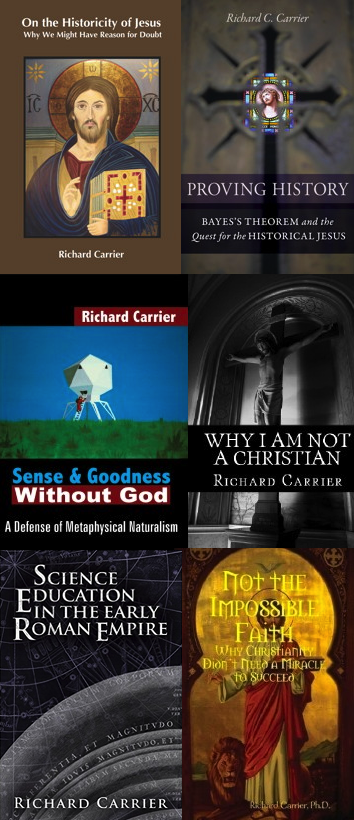This is just a brief note for those interested in my thoughts on Tim Widowfield’s article “What Is Euhemerism?” about what he thinks are confusions regarding the terminology of “Euhemerization.” For the context, see my article “Euhemerization Means Doing What Euhemerus Did.”
Widowfield is confusing what Euhemerus did, with why he did it. This is a basic mistake of Aristotelian categorization. The efficient cause is the act itself that brings about the effect. The final cause is the reason why, the goal being sought, by doing that. Those are two different things.
Aaron Adair, the astronomer who wrote the best book ever on the Star of Bethlehem (seriously, I highly recommend it, for all who want the definitive take-down of that miracle claim), will be presenting an equally well-written paper at the upcoming national meeting of the Society of Biblical Literature on this point that documents what I’m saying extensively, but it will be awhile before that will be available to cite.
TL;DR, Euhemerization is doing what Euhemerus did: convert a non-historical deity into a deified historical man (in contrast to deification, which is when an actual historical man is converted into a deity). Why he did that is actually widely debated. We don’t actually have the text in question, only hostile reactions to it, which quote selectively from it or paraphrase it (how accurately we can’t tell). But whatever his reasons for doing it, his reasons for doing it are not what he did, but why. And as Adair shows (and as do I, though less directly, in OHJ, e.g. in my discussions of Romulus and Osiris), many people did the same thing (used the same process) to accomplish different things. Some wanted to rationalize cosmic myths. Some wanted to hide them from the uninitiated. Some wanted to polemicize against them. But what they all did in common, is the same one thing: convert a non-historical deity into a deified historical man. A trend begun by Euhemerus. And thus so called.
This is the problem with trying, as Widowfield does, to create an analogy between Darwinism, which is by definition not teleological, with an actual goal-oriented human activity. The latter differentiates between the act itself and its purpose. And as such, the same act (smelting steel, say) can be turned to many more purposes than its originators intended or imagined (you can smelt steel to make swords, plowshares, or literal flying machines). What you create is different from how you use it. Euhemerus did not invent his idea, but he popularized it. How people thus inspired then used that idea varied, as each user had their own goals, which his idea could be turned to accomplishing.
And this is demonstrated in the historical record.







Isn’t this basically a verbal dispute?
You call it Euhemerization, let him call his concept Schmeuhemerization, and can’t we be done with it? 🙂
If only.
They are the ones making this about some sort of language policing of the term. I explain my meaning and use it consistently and intelligibly. That should, indeed, be the end of the matter. I do not know what motivates their desire to disallow it. Even if they were right about the term’s past usage.
There was a partile conjunction of Jupiter and Saturn a few years BC. Meaning a conjunction of Jupiter and Saturn where they both shared the same right ascension and the same ecliptic longitude. Due to the apparent retrograde motion of planets, this conjugation occurred 3 times over a period of around 6 months. This conjunction would have appeared in the sky as one bright star. This conjunction of both right ascension and ecliptic longitude is rare. Perhaps only once in 1,000 years for Jupiter and Saturn.
Read Adair’s book.
I’m still unclear about what Euhemerization is and how you apply it in your arguments about Jesus.
Do people need to believe/have believed that the deity actually exists/existed, rather than being treated as just a myth for it to be Euhemerization?
If I can take Clark Kent as an example/analogy, would it be Euhemerization to claim that there really was a person going by that name, who really lived in a real place called Metropolis, he really could fly and really was invulnerable to bullets?
Or is it Euhemerization to claim that the stories are exaggerations/distortions of what really happened? For example, Clark was adopted from the Planet/Krypton Adoption Agency whose head office burnt down shortly afterwards causing them to go bust. He was the last child of Planet/Krypton AA.
And, he grew up to be quite an athlete. A train track curved around the out skirts of his home town where freight trains had to slow down to take the bend. There was a tradition of trying to run from one level crossing to another on the other side of town to beat the trains. Clark became a local hero by managing to do it a couple of times. Etc.
When you say that Jesus was Euhemerized are you saying that he was portrayed as a real human with only the abilities a human could posses, or as a real person that really had special powers?
Would it be incorrect to label a claim that a fictional character was real, Euhemerization?
I hope this isn’t too muddled.
Clark Kent is overt fiction. And never a god. Much less one who became a god upon death. He never even dies. Nor was he worshipped as a deity before placed in history. The analogy is hosed six ways from Sunday.
So no, you clearly don’t understand Euhemerization. Perhaps you should read my discussion of it.
Euhemerization is taking an already existing God, and converting them into a human being in a specific time and place in earth history, who becomes a god (by definition after death or translation, since only by such means would one explain why they are no longer on earth).
Does one need to believe the Euhemerization to Euhemerize? Obviously not. That would be impossible. Whoever is doing it, by definition knows it’s fiction. Because the history did not precede their inventing it. They can have many purposes for inventing it. To lie. To conceal true beliefs behind the parable of it. Or to speculate. The latter would come close to believing it. But one in that case has to really deceive themselves into thinking their hypothesis was true, when they know full well they are inventing all the evidence for it.
This is not the same as the receivers of the Euhemerization. They don’t know it was invented (they might, but not necessarily). So how they then use the Euhemerization might not even have anything to do with its inventor’s motives for creating it in the first place.
I started to read OHJ from the Gospels section again. While reading it I remembered what Price said in the one interview (where you and Fitzgerald were in also); that almost everything in the Gospels can be easily understood to be rewrites of stories from Septuaginta. Do you agree with that view, or is there exceptions?
There is a mixture of LXX and Homeric emulations (some weave both). I haven’t checked to see how much of the content can be traced that way. And much of it is a “possible” rather than a “certain” anyway. I would say most of the Gospels we can’t determine the origin with sufficient certainty to argue for any conclusion (whether history or emulation or novel fiction or any mix thereof), and the remainder can all be shown to be fiction (whether emulative or not). Nothing has been verified as probable history (beyond the background “color content”).
Here’s a link to Price’s “New Testament Narrative as Old Testament Midrash” — it’s a pretty dense but very informative survey of detectable influences within the Gospels.
http://www.robertmprice.mindvendor.com/art_midrash1.htm
Can you approximate how much of a content of Mark is actually a myth? And how much do you think Mark’s Gospel has material that is undetermined? What’s the ratio?
No need. Until someone finds at least a single passage that is more likely historical, the Gospels are unusable as evidence. So we don’t need to know that ratio.
Never make extra work for yourself that you have no need of. Once you’re at QED, it’s time to move on.
To booker:
That’s really interesting! Expecially nr. 12, Stilling the storm. That has so obvious connections to tale of Jonah. I have to check what more MacDonald has to say about that.
Getting into an argument over terminology can be futile and time wasting. If everyone is wrong but will think you are wrong, or be confused, eventually you probably have to give in – language isn’t always logical.
Hi Richard,
About the definition given by Tim of euhemerism (that I like) :
Euhemerism is rationalization of mythological figures by the invention of historical figures (behind them).
…the implicit question raised by Tim is: was ‘Mark’ a real euhemerist?
I think that the answer is strictu sensu a clear ‘no’, but ‘Mark’ can be still considered an inciter of ”Jesus euhemerism” if we assume that he was selling his fiction for outsiders as ‘remembered history’ (while for insiders as allegory).
The reaction of an early non-Christian to listening of the first Gospel can only be one of three possible mutually exclusive options:
1) to remain non-Christian, or to deny everything as mere fraud (ancient Jesus mythicism).
2) to become a Christian outsider, and believe in the literal truth of all the Gospel (post-Gospel Christianity).
3) to remain non-Christian, or to rationalize the Gospels (à la Celsus, à la Tacitus) by inventing a ”historical Jesus” behind the Gospel Jesus (real Jesus euhemerism).
Therefore I think that both you and Tim should recognize that the term ‘euhemerist’ is to be applied strictu sensu only on the people who choosed the option 3 above (obviously, under your definition of minimal mythicism). Therefore, the conclusion would be, if I am right, that Pagans as Tacitus or Celsus euhemerized Jesus (after listening the first Gospel) !
Thanks in advance for any comment or correction,
Giuseppe
As my article explains, you can’t require motive in the definition of an invented activity in a case like this. They aren’t the same thing. You can historicize for many reasons, not just “rationalization.” And we have many uncanny examples of that fact. Including one listed by Plutarch for the Euhemerization of Osiris: to conceal the true cosmic doctrines behind a facade text.
The ‘existing’ god for euhemerisation is Yahuwah / Ego Eimi deity of the Jews whu becomes the man Jesus (but wholly remains Ego Eimi). Not only the deity but the OT typology/baggage is Midrash-ised.
For instance, John’s Gospel and Genesis…
Genesis: In the beginning,…darkness cover’d the urth…
John: in the beginning….on the first day of the week, when it was still dark…..
Genesis: Jesus the eden gardener is looking for his creation (the woman deceives)…
John. His creation (mary/eve reprieves) is looking for Jesus in the garden
John’s creation represents a reset.. &c
No. The Christians did not equate Jesus with Yahweh for at least half a century or more. They equated him with a created archangel subordinate to God. Still a divinity. And thus in pagan terminology a god. But not the (supreme) God.
Can I wear my tricorn and try?
Ex 17:2 KJV “Wherefore the people did chide with Moses, and said, Give us water that we may drink. And Moses said unto them, Why chide ye with me? wherefore do ye tempt the LORD?”
1Cor 10:9 KJV “Neither let us tempt Christ, as some of them also tempted, and were destroyed of serpents.”
Jude 1.5 `that JESUS, who saved a people out of the land of Egypt, afterwards destroyed those who did not believe’ [see nestl-aland 28th edition.]
Lev 11.45 I am Jehovah that brought you up out of the land of Egypt.
“… all those who in every place call upon the name of our Lord Jesus Christ, both their Lord and ours:” 1 Corinthians 1:2
“And it shall come to pass that everyone who calls on the name of Yahweh shall be saved. joel 2.32
And there’s something about bendid nees….
Perhaps the following wurk deals with this better:
Jesus as God: The New Testament Use of Theos in Reference to Jesus Murray J. Harris
and especially here: Christ is God Over All: Romans 9:5 in the Context of Romans 9-11
George Carraway
Rom. 9:5 is most likely a scribal error. And even if not, it’s no different from when Paul calls Satan a god.
You shouldn’t believe fundamentalist scholarship.
You need to follow mainstream scholarship.
Every reference to Jesus in Paul is to God’s agent and proxy. Not to God himself. As Paul explains, God assigned Jesus that role. Thus finding examples of Jesus taking that role does not show he is regarded as the same as God. Paul is very explicit that that is not what those passages mean. And the passages showing Paul saying this are numerous. I list them in a whole section in this very point in OHJ (Chapter 4, Element 10; n. 69 on Rom. 9:5). Bibliography to mainstream scholarship concurring included.
Btw, I remember you saying somewhere, that there is some evidence that Matthew was just lazy copyist. Could you say what kind of evidence there is?
Collected, and with bibliography, in OHJ, Chapter 10.5.
Has anybody written analysis about Matthew’s copyist fatigue?
You mean apart from Mark Goodacre?
It is quite astonishing what some ignorant folk will ‘correct’.
Here, I think the confusion arises from the fact that Euhemerus is claiming that Jupiter was an ancient king who was subsequently deified, his real deeds being mythologized.
In both cases there is a connection being asserted between a God and a man. In deification the arrow points from man to God. Euhemerus takes a God and asserts that he is the product of a man, the arrow points the other way.
In context, it looks as if Euhemerus could have been making a quasi atheist argument, dismissing mythical gods as merely the misremembered deeds of forgotten kings. Which would be rather different from what Richard is claiming Mark et. al. were up to. But we can’t be sure.
Note also though that Euhemerus did not invent this. His name is attached to it only because his instance of doing it made it popular.
(His motives are also difficult to ascertain. But his motives are still a different thing from what he was motivated to do.)
I’m glad we both agree I don’t understand.
What I was trying to establish was if the nature of the historical invention matters. Is Euhemerization *any* invention of a historical person from a pre-existing god? Or is it a specific type of invented pseudo history?
This is what I was trying to get at with my Clark Kent analogy.
Is the invention that a god and their associated stories were actually mythologised from a ‘real’ person and here’s his more mundane life story, Euhemerization?
If you take a pre-existing god belief and make up a normal human life for them in a specific time and place before they died and achieved godhood, is that Euhemerization?
Or is it just taking a god with stories about him occurring in the heavens and then recasting those stories as taking place on earth and the god as human at a specific point in history?
Yes.
Not all gods start out celestial (there are subterranean, nature-inhabiting, and mythic-realm deities as well). Nor do all historicizations of them map their celestial myths. Any god who is worshipped before being distinctly placed in human history, and then is placed in history, as a human later deified, has undergone the process Euhemerus used, and has therefore been Euhemerized.
Ah okay. So it’s not a particular form of historicizing a god, it’s the general process. Thank you.
Widowfield says the following:
‘A less familiar term, euhemerism, from time to time suffers similar misuse. How should we define this word? We might explain it, following Dr. Richard Carrier, as “doing what Euhemerus did.”’
But that’s already a false premise. You don’t define euhemerism as “doing what Euhemerus did” – you define euhemerisation as that. Widowfield seems to use the terms interchangeably, but I think you’re fairly careful not to.
Which leads me to risk further flogging of this particular horse by asking if it would be consistent with your use of the terms to say that:
“Euhemerism” is the assertion – as espoused by Euhemerus – that gods are a cultural artifact resulting from the accretion of myth onto stories of real historical people (and hence connoting a man-to-god transformation);
whereas
“Euhemerisation” is the activity – as practised by Euheremus – of inventing the very stories about these purportedly real people whom the gods are supposed to derive from (and hence connoting a god-to-man transformation).
(The harsh implication being, of course, that Euhemerisation is essentially the dishonest reverse-engineering of fake evidence in support of Euhemerism. But perhaps that’s too crude an interpretation.)
I’m not sure I get your point. Euhemerus never “espoused” a position. This wasn’t some doctrine he wrote a treatise on. It’s just something he did, which later authors copied and made popular.
And what was practiced by Euhemerus (what he “did”) was invent historical people to be the backstory for persons (gods) who never were historical. That’s Euhemerism—the phenomenon that results from Euhemerizing.
One could then infer from this practice a doctrine of one’s own. But Euhemerus himself never says what doctrine one is supposed to infer. So one could infer that Euhemerus really did find this source that really did establish Zeus and Uranus were once historical and thus the lesson really is that this tends to be the case. But that would then never generate any Euhemerization, and thus no Euhemerism. It would only generate a history of deifification.
Think about it.
Suppose you were someone in the 1st century AD reading Euhemerus. Your takeaway is that what he wrote is all true; and therefore you embrace the doctrine “if we check we’ll find lots of celestial gods used to be real past persons deified.” And accordingly, you go looking, doing research to find more examples. You don’t really find any other than deified kings already otherwise well-attested, so you publish your research documenting real cases of deified persons (note: no such book exists or is attested from antiquity). What you just did is write a history of deification. You didn’t do what Euhemerus did. And thus it isn’t Euhemerism you are instantiating; it’s just history, of deification.
The only way you can get a trend to name after what Euhemerus did (and not just histories of deification) is if that isn’t the doctrine people inferred or picked up from what Euhemerus did, but that rather they assumed what he did was indeed false, and concluded that this should be done for many more gods: invent histories for them, and turn them into historical persons that they never were. And so many did just that. The result is a distinct trend matching what Euhemrus did. Thus, Euhemerism, which is the phenomenon that results from Euhemerizing; and Euhemerizing is only so-called because it is distinct from deification—and thus it requires a distinct name.
At most you can get a middle case, of persons who watch all this lying happen, are duped by it, and thus call it Euhemerism: the discovery of the real historical origins of celestial gods. But that of course cannot be what any of the Euhemerizers were doing (because they were all making this stuff up, as was Euhemerus). So we can talk about “Euhemerism” in a special sense as also a theory some later dupes proposed: a theory about discovering historical origins for gods. But that isn’t what any of the creators of this stuff were doing; and it is certainly, absolutely, not at all what Euhemerus did.
So there is no way to say “Euhemerism” isn’t making up historical origins for mythical gods. At most you can say that in the hands of a few foolish third party observers, sometimes Euhemerism is used as a word to refer to discovering real historical origins for mythical gods. Even though no such literature or phenomenon actually exists.
This is of course useless for describing the actual trend itself: the actual doing of the thing, that would generate a fictional history for mythical beings like Osiris or Quirinus or Dionysus or Jesus. If you want to talk about how a story came to be, you can only talk about the actual Euhemerism, the only trend that actually existed: invention. Only if you want to talk about later idiots who were duped by that trend would the other notion come up. And that wouldn’t have anything to do with the production of texts, nor anything to do with what actually happened (in the hands of Euhemerus and many other authors) that actually has any relevant connection to producing the Gospels.